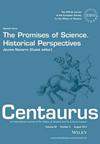Mythological Endings: John Snow (1813–1858) and the History of American Epidemiology
IF 0.5
1区 哲学
Q3 HISTORY & PHILOSOPHY OF SCIENCE
引用次数: 0
Abstract
During the COVID-19 epidemic, the name of the 19th-century English physician John Snow (1813-1858) has cropped up to a surprising extent, notably in connection with the severe cholera epidemic of 1854 in the district of Golden Square, London. It is repeatedly stated that Snow brought this epidemic of waterborne disease to an end by removing the handle of the Broad Street pump. It is also widely known that this story is a myth. Nonetheless, the Broad Street pump story as told by Snow's close friend Benjamin Ward Richardson remains embedded, partly, it is argued, because of its appeal to areas of the cultural consciousness. In America, Snow and his work on the epidemiology of cholera, including the Broad Street pump story, achieved a serious status which has endured, in one form or another, to the present day. In contrast to Britain, the heroic age of public health in America coincided with the optimism of the bacteriological revolution and higher hopes for medical science. However, this rapidly changing environment exacerbated differences of opinion as to what the small and emergent specialty of epidemiology should look like, what its project was, and where it should be based. Different versions of Snow's persona came to represent basic and often conflicting conceptions of epidemiology and the status (or lack of it) of its practitioners. For many, consciously or otherwise, the removal of the Broad Street pump handle remained an individualistic triumph, a single human intervention which resembled modern medicine in providing a "cure."神话的结局:约翰·斯诺(1813-1858)与美国流行病学史
在新冠肺炎疫情期间,19世纪英国医生约翰·斯诺(1813-1858)的名字出人意料地出现了,尤其是与1854年伦敦金色广场地区的严重霍乱疫情有关。人们一再指出,斯诺通过拆除布罗德街水泵的把手,结束了这种水传播疾病的流行。众所周知,这个故事是个神话。尽管如此,斯诺的密友本杰明·沃德·理查森(Benjamin Ward Richardson)讲述的布罗德街水泵的故事仍然根深蒂固,有人认为,部分原因是它对文化意识领域的吸引力。在美国,斯诺和他在霍乱流行病学方面的工作,包括布罗德街水泵的故事,取得了一种严重的地位,这种地位以某种形式一直延续到今天。与英国相比,美国公共卫生的英雄时代恰逢细菌革命的乐观主义和对医学的更高希望。然而,这种快速变化的环境加剧了人们对流行病学这一小而新兴的专业应该是什么样子、它的项目是什么以及它应该建立在哪里的意见分歧。斯诺人物形象的不同版本代表了流行病学及其从业者的地位(或缺乏)的基本概念,这些概念往往相互矛盾。对许多人来说,无论是有意还是无意,拆除布罗德街水泵手柄仍然是个人主义的胜利,这是一种类似于现代医学的单一人类干预,可以提供“治愈”
本文章由计算机程序翻译,如有差异,请以英文原文为准。
求助全文
约1分钟内获得全文
求助全文
来源期刊

Centaurus
HISTORY & PHILOSOPHY OF SCIENCE-
CiteScore
3.10
自引率
25.00%
发文量
52
审稿时长
>12 weeks
期刊介绍:
Centaurus publishes an international spectrum of original research papers, historiographical articles, and other academic content on the history of science in the broadest sense, including mathematics, medicine, biomedical sciences, earth sciences, social sciences, humanities and technology, and their social and cultural aspects. We also invite contributions that build a bridge between history of science and other disciplines. Book notices, book reviews and essay reviews of publications within the journal''s scope are commissioned to experts. The Editor encourages suggestions for special issues, short papers on topics of current interest and articles suited to open peer commentary along with a list of potential commentators.
 求助内容:
求助内容: 应助结果提醒方式:
应助结果提醒方式:


